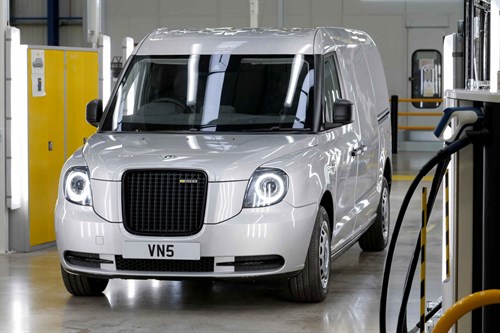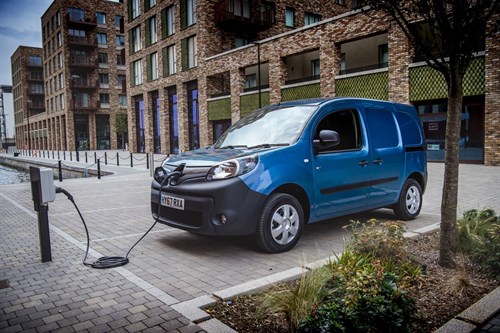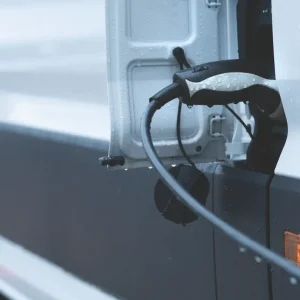For many years, hybrid powertrains have been a growing presence in the passenger car market, offering some of the environmental benefits of fully electric vehicles without the associated range anxiety and charging concerns.
However, this hasn’t been replicated in the LCV market, despite such vehicles having often served as an effective ‘bridge’ option for electrifying fleets. Even over the past couple of years as more fully electric vans have started to be unveiled, hybrids have been conspicuous by their absence.
But notwithstanding the government’s recent announcement that hybrid vehicles should be banned alongside regular petrols and diesels from 2035, a couple of high-profile newcomers are starting to change that.
The first of these is not technically a hybrid at all, but a range-extender. The LEVC VN5 combines an electric motor with a petrol engine, like hybrids do, but the petrol engine does not drive the wheels, instead only being used to charge the battery, which can also be charged using a plug.
This means that an electric range of 63 miles is claimed without having to use the petrol engine at all, but if a longer trip is needed the van can go up to 301 miles without charging – and then potentially even further just by filling up at a conventional petrol station.
When asked for the advantages of a range-extender powertrain over a full electric model, an LEVC spokesperson names speed of charging as a key factor, with a full charge possible in less than 30 minutes.
They add: “LEVC’s VN5 is designed to provide ‘distribution to door’ – not just last-mile – capability, creating a link between out-of-town depots and city centres. Based on a real-world 47-mile delivery route into central London, the VN5 can make approximately twice the amount of journeys and deliveries as its [electric] segment competitors, by having the flexibility to operate emission- (and penalty-) free in the city’s restricted ULEZ (ultra-low emission zone) environment.”
When asked if they were worried that range-extender technology might be made obsolete by improvements in pure-electric powertrains and infrastructure, the spokesperson says: “LEVC is confident that this technology is optimal for the current ‘transitional’ period, offering commercial operators complete peace of mind.”
The other new hybrid van on the market is a new version of the UK’s bestselling LCV, the Ford Transit Custom.
The new PHEV, or plug-in hybrid model, also pairs a petrol engine with an electric motor, and is capable of an electric driving range of up to 35 miles.
Ford previously announced that it expects 10% of total Transit Custom sales to be PHEVs within two years.
At a launch event late last year, the manufacturer said it believes that in the short to medium term the Custom PHEV presents the most practical option available for operators trying to meet clean-air targets in cities, before charging infrastructure is improved and the battery ranges of pure-electric vans extended.
Mark Harvey, director of Ford’s Urban Electrified Van programme, said at the time: “Emissions-free mobility is essential for the future of our cities and their citizens, but we know there are still barriers we face in the move to electrification.
“We also know that businesses still have legitimate concerns about the range of fully electric vehicles, as well as their cost-effectiveness and reliability.”
Away from the high-profile newcomers, there is one established name in the hybrid LCV space, that of Mitsubishi. One of its contenders in the niche 4×4 LCV segment, the Outlander PHEV Commercial, is based on the car model of the Outlander, which has proved a big hit with cost-conscious motorists in recent years.

LEVC’s VN5 can be charged in under 30 minutes
(continued from page 1) When asked what Mitsubishi felt the advantages of the powertrain were over fully electric or conventional petrol or diesel LCVs, the firm’s general manager for fleet operations in the UK Clive Messenger says: “It very much depends on the needs of the business, but as public opinion is focused on protecting the environment more than ever, companies will increasingly want to switch to electrified vehicles.
“Unlike most passenger cars, however, LCVs don’t experience a lot of downtime so recharge times, not to mention the availability, speed and reliability of charging points, are still major barriers. PHEVs allow businesses to use a combination of electric and petrol for longer journeys, minimising downtime, while providing a zero-emission cost alternative in clean-air zones, which also saves on congestion/emission charges and the higher fuel consumption associated with city driving.
“Because the battery is smaller they can be charged relatively quickly too, so they can be topped up regularly to ensure they’re delivering genuine savings and greener deliveries.”
According to Messenger, the ability of PHEVs to cope with both short and long-range trips is part of their appeal.
“Research into electric commercial vehicle use in London indicated that they were covering on average 11 miles per day,” he says. “That’s well within the range of even a fully laden Outlander PHEV Commercial.
“But if that vehicle needs to deviate or go on a longer trip, an EV LCV will find that challenging whereas a PHEV can switch to hybrid mode outside of the clean-air zone and cover hundreds of miles with no range worries.”
When asked if Mitsubishi has any plug-in hybrid obsolescence concerns, Messenger says that in fact it sees PHEVs becoming more important than ever in the coming years.
“Despite the zero-emission announcements, transport CO2 emissions are actually rising as people move to petrol vehicles from diesels,” he says.
“The take-up of EVs is growing but not at the rate it needs to to meet future emissions targets. It will take time and significant investment before the public has absolute confidence in the charging infrastructure, and while EV range is improving, the costs and recharge times are still a major barrier.
“PHEVs have an important role to play in bridging the gap, helping build the commercial viability of the growing charging network, getting sceptical drivers familiar and comfortable with charging and electric driving, and keeping motorists moving when charge points are busy, slow or non-operational.”
Despite the new wave of hybrids, other manufacturers are standing firm on only pure-electric LCVs being the future. One of these is PSA Group – owner of Peugeot, Citroen and Vauxhall – which is particularly interesting given that the company is currently introducing high-profile PHEV models into its car ranges.
When asked why these different approaches were being taken between cars and LCVs, Marko Engel, the firm’s UK head of electric vehicles and infrastructure, explains that pure-electric vehicles will better fit the everyday usage requirements of the majority of its van customers.
He says: “Just like with passenger cars we have many different customers, all of which will have different uses and requirements for their vans. Some vans will travel a significant number of miles each day on the motorway whilst other vans are utilised for local last-mile deliveries.
“Operating a fully electric van will fit the everyday usage requirements for many customers and the van will always be zero CO2 and NOx emission at the tailpipe, allowing access to government purchase grants and any zero-emission zones.”
When asked if customers are becoming better informed about electric vans, Engel says: “Generally, yes, as is the population as a whole. Clearly, we as a manufacturer and the government have a role to play in that education piece, but we are gaining traction as more and more manufacturers begin to sell EVs.
“Attitudes towards electric vehicles do vary significantly and there is a steep learning curve in switching to electric vehicles – the fleets that we have seen manage this well have generally operated trials with a small group of vehicles first, so they can demonstrate the positive effect on their own business, as well as have driver advocates which can inform and influence others.”
According to Engel, PSA also has an answer to concerns that are regularly raised about manufacturing capacity for pure-electric vehicles: “Our entire business model has shifted to multi-energy platforms (same car/van – different drivetrains) as this gives us a far greater degree of flexibility in production (versus standalone electric vehicles) and we are confident that we can manufacture our planned volumes of electric vehicles.”
Dr Colin Herron, managing director of Zero Carbon Futures, is one industry figure who has concerns about production capacity for fully electric vans – although he does not necessarily think PHEVs will be the answer to this.
He says: “Van registration in the EU in 2019 was 2.1 million vehicles. I would think all EV van production both BEV (battery electric vehicle) and PHEV in the EU is about 50,000 to 60,000 or 3% of what is required.
“Unless the main carmakers turn over whole van plants to PHEV or import hundreds of thousands then I am afraid no [they will not solve production problems].”
Herron also says that since PHEVs have both an internal combustion engine and an electric motor, they are expensive to build and maintain, while a pure-electric vehicle, once the battery cost is sorted, is simpler to build and incurs “almost no maintenance cost”.
When asked if hybrids are a good compromise for fleets worried about emissions but unwilling to commit to fully electric power, Herron says it is likely to come down to costs:
“I accept some companies are doing this out of social responsibility but for many it’s both image but [also] an accountancy exercise.
“If vans are going into a low-emission zone stating that a minimum distance can be achieved zero-emission (WLTP [Worldwide Harmonised Light Vehicle Test Procedure] and not NEDC – [New European Driving Cycle] – as it is meaningless) then a PHEV could do the job. If the vans are doing long-distance deliveries then, yes, a PHEV.If they are working in London within the ULEZ then PHEV-limited battery range may not be enough.”
(continued on page 3)
It’s not easy being green: As new electric LCV sales gather pace, what is the effect on the used market? Ian Shaw takes a look

Of the 60,000 plug-in vehicles sold in the UK back in 2018 less than 1,000 were light commercials
Over the past few years you cannot fail to have seen the gradual growth of the electric car, nor equally that the uptake of electric vans has trailed behind.
It would be fair to say that some of this is down to design. Most car makers are electrifying existing models – if you can place a motor where the engine and gearbox once lived and the batteries where the fuel tank was then all is well. However, most have a loss of boot space, and you cannot afford to lose space in a van. Weight is also a penalty, and payload suffers at the hands of battery mass.
Some makers have got around the issue. The Renault Master Z.E. has a large engine bay where once a substantial diesel engine and gearbox lived – by fitting both the motor and the battery there, the load bay is unaffected. The downside, though, is that the electric motor is the same as the much smaller Kangoo Z.E., reducing range and performance.
With electric LCVs (ELCVs) being more expensive than regular models, is going down the used van route a better way into electric motion? Firstly, maintenance is minimal: tyres are the only area with parity, brakes wear less due to regenerative braking, and there are no lubricants, timing belts, fuel system or main transmission parts to consider.
By contrast, the big unknown is battery life, and replacements cost about the same as a new engine and gearbox, although leasing systems are negating this aspect. So the biggest cost in running an electric van is the same as any other van: depreciation, which depends on supply and demand.
Of the 60,000 plug-in vehicles sold in the UK in 2018 – the last full-year figures available – less than 1,000 were vans, with the Nissan eNV200 at almost 600 units and the Renault Kangoo Z.E. at just over 300 sales. Compared to electric cars, it’s a tiny figure. Full-electric, hybrid and alternative-fuel models took 2.5% of the new car sales but notched-up less than 0.3% of LCV sales. That meant an average three-year old electric van would be worth over 70% of its new price, with a diesel van in the same sector fetching a more expected 52%.
One proviso here is the operating pattern, with the electric LCV’s average mileage being only one-fifth of that of the diesel van.
We found that to be reflected in the vans on sale currently. Renault’s Kangoo Z.E. starts at under £5k for a 2011 61-plate with 18,000 miles on it, and goes up to £8,000 for a 2016 66-plate that had covered only 590 miles from new. Nissan’s eNV200 can be found from £10,000 for a 2014 64-plater with 70,000 miles on the clock, through to a 2017 model with 12,000 miles at £15,000. The slow take-up on ELCVs might yield a good deal at the front end: we found one dealer knocking some £6k off the new price of an unregistered LDV EV80 3.5t panel van, although that still meant an asking price of £56,950.
Early adopters of ELCVs will see very little loss in the first three years with the promise of low running costs attracting used buyers, so now might be a good time to switch. As they inevitably become more popular the used values will reduce (but probably will not equalise for five years or more yet), although they cannot be affected by ever-changing emission laws, in the way diesel van residuals have.
Second-hand buys
|
Year |
Plate |
Mileage |
Price ex.VAT |
Version |
|
2011 |
61 |
18,000 |
4,995 |
Renault Kangoo Z.E. |
|
2016 |
66 |
590 |
7,995 |
Renault Kangoo Z.E. |
|
2014 |
64 |
70,000 |
9,995 |
Nissan eNV200 |
|
2017 |
17 |
12,200 |
14,995 |
Nissan eNV200 |
|
2020 |
69 |
delivery |
56,950 |
LDV EV80 3.5t |





